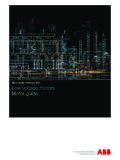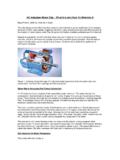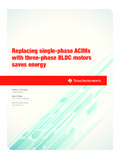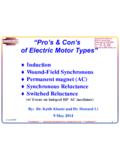Transcription of Sensorless Field Oriented Control of 3-Phase …
1 Application Report SPRABQ0 October 2013. Sensorless Field Oriented Control of 3-Phase induction Motors Using F2833x Manish Bhardwaj ABSTRACT. This application report presents a solution to Control an AC induction motor using floating point TMS320F2833x microcontrollers. TMS320F2833x devices are part of the family of C2000 . microcontrollers which enable cost-effective design of intelligent controllers for three phase motors by reducing the system components and increase efficiency. With these devices it is possible to realize far more precise digital vector Control algorithms like Field Orientated Control (FOC). This algorithm's implementation is discussed in this document using TI's Digital motor Control (DMC) Library. The FOC. algorithm maintains efficiency in a wide range of speeds and takes into consideration torque changes with transient phases by processing a dynamic model of the motor . Among the solutions proposed are ways to eliminate the phase current sensors and use an observer for speed Sensorless Control .
2 The DMC Library uses TI's IQ math library, which supports both fixed and floating point maths. This makes migrating from floating to fixed point devices easy. A configuration for TMS320F2803x, which is a fixed point microcontroller, is available in the project to highlight this. This application report covers the following: A theoretical background on Field Oriented motor Control principle. Incremental build levels based on modular software blocks Experimental results Contents 1 Introduction .. 3. 2 induction Motors .. 4. 3 Field Oriented Control .. 6. 4 Benefits of 32-Bit C2000 Controllers for Digital motor Control (DMC) .. 12. 5 TI Literature and Digital motor Control (DMC) Library .. 13. 6 Hardware Configuration (HVDMC Kit) .. 17. 7 Incremental System Build for ACI Sensorless Project .. 21. 8 References .. 43. List of Figures 1 induction motor Rotor .. 4. 2 Squirrel Cage Rotor AC induction motor Cutaway 5. 3 Separated Excitation DC motor Model.
3 6. 4 Stator Current Space Vector and Its Component in (a,b,c) .. 7. 5 Stator Current Space Vector and Its Component in the Stationary Reference Frame .. 8. 6 Stator Current Space Vector and Its Component in ( , ) and in the d,q Rotating Reference Frame .. 8. 7 Basic Scheme of FOC for ACI motor .. 9. 8 Current, Voltage and Rotor Flux Space Vectors in the d,q Rotating Reference Frame and Their Relationship With a,b,c and ( , ) Stationary Reference Frame .. 10. 9 Overall Block Diagram .. 11. C2000, Code Composer Studio are trademarks of Texas Instruments. Windows is a registered trademark of Microsoft Corporation. All other trademarks are the property of their respective owners. SPRABQ0 October 2013 Sensorless Field Oriented Control of 3-Phase induction Motors Using F2833x 1. Submit Documentation Feedback Copyright 2013, Texas Instruments Incorporated 10 A 3-ph induction motor Drive Implementation .. 15. 11 Software Flow .. 16. 12 Using AC Power to Generate DC Bus Power.
4 18. 13 Using External DC Power Supply to Generate DC-Bus for the Inverter .. 19. 14 Watch Window Variables .. 20. 15 SVGEN Duty Cycle Outputs Ta, Tb, Tc and Tb-Tc .. 22. 16 DAC-1-4 Outputs Showing Ta, Tb, Tc and Tb-Tc Waveforms .. 23. 17 Level 1 Incremental System Build Block Diagram .. 24. 18 Calculated Phase A and B Voltages By Volt1 Module, , and .. 25. 19 The Waveforms of Phase A Voltage and Current and Phase B Voltage and Current .. 26. 20 Amplified Phase A Current .. 27. 21 Level 2 Incremental System Build Block Diagram .. 28. 22 , Phase A Voltage, and Phase A and B Current Waveforms .. 30. 23 Level 3 Incremental System Build Block Diagram .. 32. 24 Estimated d and q Fluxes With Estimated Theta and Phase A Current Waveform .. 33. 25 Level 4 Incremental System Build Block Diagram .. 34. 26 Level 5A Incremental System Build Block Diagram .. 37. 27 Level 5B Incremental System Build Block Diagram .. 38. 28 Phase A and B Current With Estimated Theta and Phase A Voltage Waveforms.
5 40. 29 Flux and Torque Components of the Stator Current in the Synchronous Reference Frame .. 40. 30 Level 6A Incremental System Build Block Diagram .. 41. 31 Level 6B Incremental System Build Block Diagram .. 42. List of Tables 1 Testing Modules in Each Incremental System Build .. 21. 2 Sensorless Field Oriented Control of 3-Phase induction Motors Using F2833x SPRABQ0 October 2013. Submit Documentation Feedback Copyright 2013, Texas Instruments Incorporated Introduction 1 Introduction The motor Control industry is a strong, aggressive sector. To remain competitive new products must address several design constraints including cost reduction, power consumption reduction, power factor correction, and reduced EMI radiation. In order to meet these challenges advanced Control algorithms are necessary. Embedded Control technology allows both a high level of performance and system cost reduction to be achieved. According to market analysis, the majority of industrial motor applications use AC induction motors.
6 The reasons for this are higher robustness, higher reliability, lower prices and higher efficiency (up to 80%) on comparison with other motor types. However, the use of induction motors is challenging because of its complex mathematical model, its non linear behavior during saturation and the electrical parameter oscillation which depends on the physical influence of temperature. These factors make the Control of induction motor complex and call for use of a high performance Control algorithms such as vector Control and a powerful microcontroller to execute this algorithm. During the last few decades the Field of controlled electrical drives has undergone rapid expansion due mainly to the benefits of microcontrollers. These technological improvements have enabled the development of very effective AC drive Control with lower power dissipation hardware and more accurate Control structures. The electrical drive controls become more accurate in the sense that not only are the DC quantities controlled but also the three phase AC currents and voltages are managed by so-called vector controls.
7 This document briefly describes the implementation of the most efficient form of a vector Control scheme: the Field Orientated Control (FOC) method. The FOC method is based on three major points: Machine current and voltage space vectors The transformation of a three-phase speed- and time-dependent system into a two coordinate time invariant system Effective Space Vector Pulse Width Modulation pattern generation These algorithms allow the Control of an AC machine to acquire every advantage of DC machine Control and free itself from mechanical commutation drawbacks. Furthermore, this Control structure, by achieving a very accurate steady state and transient Control , leads to high dynamic performance in terms of response times and power conversion. SPRABQ0 October 2013 Sensorless Field Oriented Control of 3-Phase induction Motors Using F2833x 3. Submit Documentation Feedback Copyright 2013, Texas Instruments Incorporated induction Motors 2 induction Motors induction motors derive their name from the way the rotor magnetic Field is created.
8 The rotating stator magnetic Field induces currents in the short circuited rotor. These currents produce the rotor magnetic Field , which interacts with the stator magnetic Field , and produces torque, which is the useful mechanical output of the machine. The three phase squirrel cage AC induction motor is the most widely used motor . The bars forming the conductors along the rotor axis are connected by a thick metal ring at the ends, resulting in a short circuit as shown in Figure 1. The sinusoidal stator phase currents fed in the stator coils create a magnetic Field rotating at the speed of the stator frequency ( s). The changing Field induces a current in the cage conductors, which results in the creation of a second magnetic Field around the rotor wires. As a consequence of the forces created by the interaction of these two fields, the rotor experiences a torque and starts rotating in the direction of the stator Field . Skewed Cage Bars End Rings Figure 1.
9 induction motor Rotor As the rotor begins to speed up and approach the synchronous speed of the stator magnetic Field , the relative speed between the rotor and the stator flux decreases, decreasing the induced voltage in the stator and reducing the energy converted to torque. This causes the torque production to drop off, and the motor will reach a steady state at a point where the load torque is matched with the motor torque. This point is an equilibrium reached depending on the instantaneous loading of the motor . In brief: Since the induction mechanism needs a relative difference between the motor speed and the stator flux speed, the induction motor rotates at a frequency near, but less than, that of the synchronous speed. This slip must be present, even when operating in a Field - Oriented Control regime. The rotor in an induction motor is not externally excited. This means that there is no need for slip rings and brushes. This makes the induction motor robust, inexpensive and need less maintenance.
10 Torque production is governed by the angle formed between the rotor and the stator magnetic fluxes. In Figure 2 the rotor speed is denoted by . Stator and rotor frequencies are linked by a parameter called the slip s, expressed in per unit as s = ( s - r) / s. 4 Sensorless Field Oriented Control of 3-Phase induction Motors Using F2833x SPRABQ0 October 2013. Submit Documentation Feedback Copyright 2013, Texas Instruments Incorporated induction Motors Rotor rotation ia A'. W Stator flux B. C' WS. Rotor flux WR. C. B'. Aluminum bar A. Figure 2. Squirrel Cage Rotor AC induction motor Cutaway View w w : AC supply freq (rad / s ) .. Stator rotating Field speed (rad / s ) : W = s s s s s . s p p : stator poles pairs number . w Rotor rotating speed (rad / s ) : W = (1 - s ) W = (1 - s ) s s s p where s is called the slip : it represents the difference between the synchronous frequency and the actual motor rotating speed. SPRABQ0 October 2013 Sensorless Field Oriented Control of 3-Phase induction Motors Using F2833x 5.














